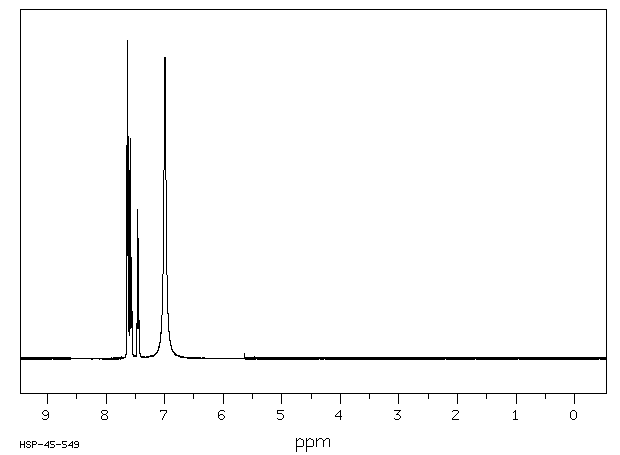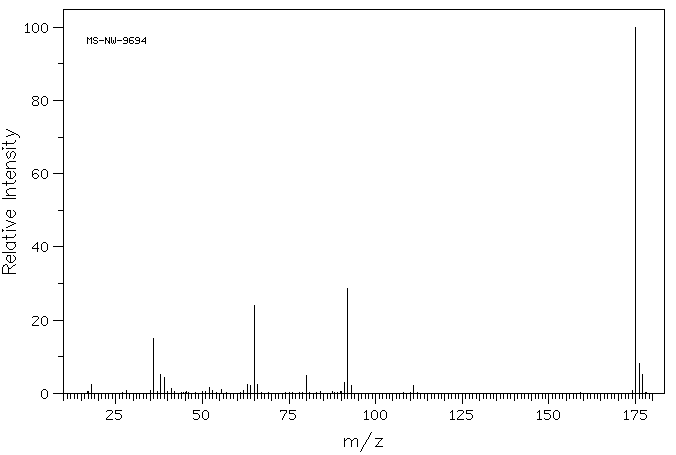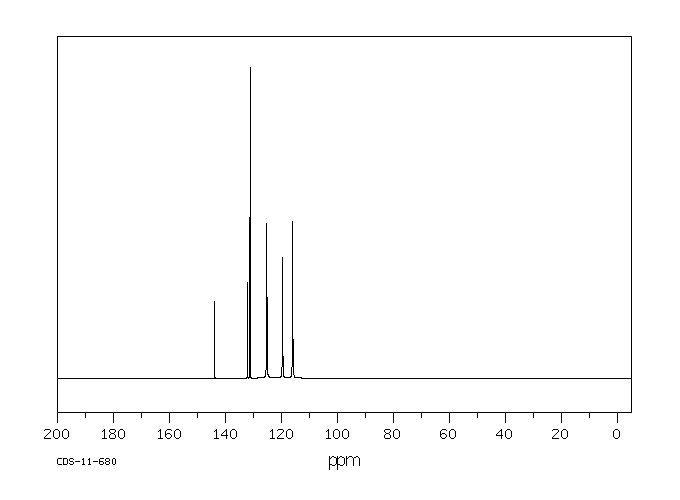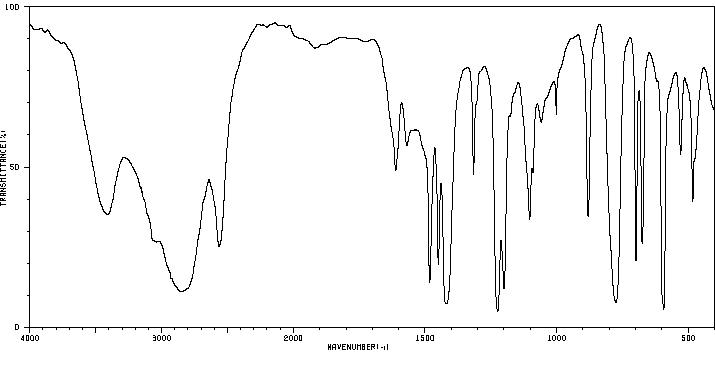3-氨基苯磺酰氟盐酸盐 | 3887-48-7
中文名称
3-氨基苯磺酰氟盐酸盐
中文别名
——
英文名称
3-aminobenzenesulfonyl fluoride hydrochloride
英文别名
3-aminobenzenesulfonyl fluoride;hydron;chloride
CAS
3887-48-7
化学式
C6H6FNO2S*ClH
mdl
MFCD00012972
分子量
211.644
InChiKey
KTADZFWRDLKHKW-UHFFFAOYSA-N
BEILSTEIN
——
EINECS
——
-
物化性质
-
计算性质
-
ADMET
-
安全信息
-
SDS
-
制备方法与用途
-
上下游信息
-
文献信息
-
表征谱图
-
同类化合物
-
相关功能分类
-
相关结构分类
计算性质
-
辛醇/水分配系数(LogP):0.8
-
重原子数:12
-
可旋转键数:1
-
环数:1.0
-
sp3杂化的碳原子比例:0.0
-
拓扑面积:68.5
-
氢给体数:2
-
氢受体数:4
安全信息
-
危险品标志:C
-
安全说明:S26
-
危险类别码:R36/37/38,R34,R22
-
海关编码:2921499090
-
WGK Germany:3
SDS
| Name: | M-Aminobenzenesulfonyl Fluoride Hydrochloride 98% Material Safety Data Sheet |
| Synonym: | None known |
| CAS: | 3887-48-7 |
Synonym:None known
Section 2 - COMPOSITION, INFORMATION ON INGREDIENTS
| CAS# | Chemical Name | content | EINECS# |
| 3887-48-7 | Benzenesulfonyl Fluoride, 3-Amino-, Hy | 98 | 223-429-7 |
Risk Phrases: 36/37/38
Section 3 - HAZARDS IDENTIFICATION
EMERGENCY OVERVIEW
Irritating to eyes, respiratory system and skin.Corrosive.
Potential Health Effects
Eye:
Contact with eyes may cause severe irritation, and possible eye burns. May cause chemical conjunctivitis and corneal damage.
Skin:
May cause severe irritation and possible burns. May cause skin rash (in milder cases), and cold and clammy skin with cyanosis or pale color.
Ingestion:
May cause severe and permanent damage to the digestive tract. May cause gastrointestinal irritation with nausea, vomiting and diarrhea. May cause perforation of the digestive tract. The toxicological properties of this substance have not been fully investigated. May cause systemic effects.
Inhalation:
May cause severe irritation of the respiratory tract with sore throat, coughing, shortness of breath and delayed lung edema. The toxicological properties of this substance have not been fully investigated. Aspiration may lead to pulmonary edema. May cause systemic effects. Can produce delayed pulmonary edema.
Chronic:
Chronic inhalation and ingestion may cause chronic fluoride poisoning (fluorosis) characterized by weight loss, weakness, anemia, brittle bones, and stiff joints. Effects may be delayed.
Chronic exposure to fluoride compounds may cause systemic toxicity.
Section 4 - FIRST AID MEASURES
Eyes: Get medical aid. Do NOT allow victim to rub eyes or keep eyes closed. Extensive irrigation with water is required (at least 30 minutes).
Skin:
Get medical aid immediately. Immediately flush skin with plenty of water for at least 15 minutes while removing contaminated clothing and shoes. Wash clothing before reuse. Destroy contaminated shoes.
Ingestion:
Never give anything by mouth to an unconscious person. Get medical aid. Do NOT induce vomiting. If conscious and alert, rinse mouth and drink 2-4 cupfuls of milk or water.
Inhalation:
Remove from exposure and move to fresh air immediately. If not breathing, give artificial respiration. If breathing is difficult, give oxygen. Get medical aid. Do NOT use mouth-to-mouth resuscitation. If breathing has ceased apply artificial respiration using oxygen and a suitable mechanical device such as a bag and a mask.
Notes to Physician:
Treat symptomatically and supportively.
Section 5 - FIRE FIGHTING MEASURES
General Information:
As in any fire, wear a self-contained breathing apparatus in pressure-demand, MSHA/NIOSH (approved or equivalent), and full protective gear. During a fire, irritating and highly toxic gases may be generated by thermal decomposition or combustion.
Extinguishing Media:
Use agent most appropriate to extinguish fire. Use water spray, dry chemical, carbon dioxide, or appropriate foam.
Section 6 - ACCIDENTAL RELEASE MEASURES
General Information: Use proper personal protective equipment as indicated in Section 8.
Spills/Leaks:
Vacuum or sweep up material and place into a suitable disposal container. Clean up spills immediately, observing precautions in the Protective Equipment section. Avoid generating dusty conditions.
Provide ventilation.
Section 7 - HANDLING and STORAGE
Handling:
Wash thoroughly after handling. Use with adequate ventilation.
Minimize dust generation and accumulation. Do not breathe dust, vapor, mist, or gas. Do not get in eyes, on skin, or on clothing.
Wash clothing before reuse. Discard contaminated shoes.
Storage:
Store in a tightly closed container. Store in a cool, dry, well-ventilated area away from incompatible substances.
Section 8 - EXPOSURE CONTROLS, PERSONAL PROTECTION
Engineering Controls:
Facilities storing or utilizing this material should be equipped with an eyewash facility and a safety shower. Use adequate ventilation to keep airborne concentrations low.
Exposure Limits CAS# 3887-48-7: Personal Protective Equipment Eyes: Wear appropriate protective eyeglasses or chemical safety goggles as described by OSHA's eye and face protection regulations in 29 CFR 1910.133 or European Standard EN166.
Skin:
Wear appropriate protective gloves to prevent skin exposure.
Clothing:
Wear appropriate protective clothing to prevent skin exposure.
Respirators:
A respiratory protection program that meets OSHA's 29 CFR 1910.134 and ANSI Z88.2 requirements or European Standard EN 149 must be followed whenever workplace conditions warrant respirator use.
Section 9 - PHYSICAL AND CHEMICAL PROPERTIES
Physical State: Solid
Color: light yellow to light brown
Odor: none reported
pH: Not available.
Vapor Pressure: Not available.
Viscosity: Not available.
Boiling Point: Not available.
Freezing/Melting Point: 200 deg C
Autoignition Temperature: Not applicable.
Flash Point: Not applicable.
Explosion Limits, lower: Not available.
Explosion Limits, upper: Not available.
Decomposition Temperature:
Solubility in water:
Specific Gravity/Density:
Molecular Formula: C6H6FNO2S.HCl
Molecular Weight: 211.64
Section 10 - STABILITY AND REACTIVITY
Chemical Stability:
Stable at room temperature in closed containers under normal storage and handling conditions.
Conditions to Avoid:
Incompatible materials, dust generation, excess heat.
Incompatibilities with Other Materials:
Oxidizing agents.
Hazardous Decomposition Products:
Carbon monoxide, oxides of nitrogen, oxides of sulfur, irritating and toxic fumes and gases, carbon dioxide, hydrogen fluoride gas.
Hazardous Polymerization: Has not been reported
Section 11 - TOXICOLOGICAL INFORMATION
RTECS#:
CAS# 3887-48-7 unlisted.
LD50/LC50:
Not available.
Carcinogenicity:
Benzenesulfonyl Fluoride, 3-Amino-, Hydrochloride - Not listed by ACGIH, IARC, or NTP.
Section 12 - ECOLOGICAL INFORMATION
Section 13 - DISPOSAL CONSIDERATIONS
Dispose of in a manner consistent with federal, state, and local regulations.
Section 14 - TRANSPORT INFORMATION
IATA
Shipping Name: CORROSIVE SOLID, N.O.S.*
Hazard Class: 8
UN Number: 1759
Packing Group: II
IMO
Shipping Name: CORROSIVE SOLID, N.O.S.
Hazard Class: 8
UN Number: 1759
Packing Group: II
RID/ADR
Shipping Name: CORROSIVE SOLID, N.O.S.
Hazard Class: 8
UN Number: 1759
Packing group: II
Section 15 - REGULATORY INFORMATION
European/International Regulations
European Labeling in Accordance with EC Directives
Hazard Symbols: XI
Risk Phrases:
R 36/37/38 Irritating to eyes, respiratory system
and skin.
Safety Phrases:
S 24/25 Avoid contact with skin and eyes.
S 28A After contact with skin, wash immediately with
plenty of water.
S 37 Wear suitable gloves.
S 45 In case of accident or if you feel unwell, seek
medical advice immediately (show the label where
possible).
WGK (Water Danger/Protection)
CAS# 3887-48-7: No information available.
Canada
CAS# 3887-48-7 is listed on Canada's NDSL List.
CAS# 3887-48-7 is not listed on Canada's Ingredient Disclosure List.
US FEDERAL
TSCA
CAS# 3887-48-7 is listed on the TSCA inventory.
SECTION 16 - ADDITIONAL INFORMATION
N/A
反应信息
-
作为反应物:描述:参考文献:名称:Carbonic anhydrase inhibitors - Part 49: Synthesis of substituted ureido and thioureido derivatives of aromatic/heterocyclic sulfonamides with increased affinities for isozyme I摘要:Reaction of nine aromatic/heterocyclic sulfonamides containing a free amino group with aryl isocyanates/isothiocyanates or allyl isothiocyanate afforded the corresponding urea/thiourea derivatives, which were characterized by standard physico-chemical procedures and assayed as inhibitors of three isozymes of carbonic anhydrase (CA), i.e. hCA I, hCA II and bCA IV (h = human, b = bovine isozyme). Another series of compounds, 1,5-disubstituted-2-thiobiuret derivatives, were prepared by reaction of 3,4-dichlorophenyl isocyanate with thioureido-containing aromatic/heterocyclic sulfonamides. Good inhibition of all these three CA isozymes was observed with the new compounds, but an exciting finding was that the ureas/thioureas and especially the above-mentioned thiobiurets reported here have an increased affinity to the slow isozyme hCA I, generally less susceptible to inhibition by sulfonamides, as compared to the rapid isozymes hCA II and bCA IV. Some of the new compounds might constitute good lead molecules for developing more selective CA I inhibitors. (C) Elsevier, Paris.DOI:10.1016/s0223-5234(98)80033-0
文献信息
-
Photographic products and processes employing azo dyes, azo申请人:Eastman Kodak Company公开号:US04156609A1公开(公告)日:1979-05-29Photographic elements, diffusion transfer assemblages and processes are described which employ a novel nondiffusible compound having a novel releasable azo dye. The dyes are azophenols, or precursors of azophenols, and have electron withdrawing groups in each of the positions ortho to the phenolic hydroxy group.
-
2-Ethynylbenzaldehyde-Based, Lysine-Targeting Irreversible Covalent Inhibitors for Protein Kinases and Nonkinases作者:Peng Chen、Guanghui Tang、Chengjun Zhu、Jie Sun、Xuan Wang、Menghua Xiang、Huisi Huang、Wei Wang、Lin Li、Zhi-Min Zhang、Liqian Gao、Shao Q. YaoDOI:10.1021/jacs.2c11595日期:——selective small-molecule inhibitors of ABL kinase by selectively targeting the conserved catalytic lysine in the enzyme. We showed the resulting compounds were cell-active, capable of covalently engaging endogenous ABL kinase in K562 cells with long-residence time and few off-targets. We further validated the generality of this strategy by developing EBA-based irreversible inhibitors against EGFR (a kinase)近年来,以赖氨酸为靶点的不可逆共价抑制剂引起了越来越多的兴趣,特别是在激酶研究领域。尽管取得了令人鼓舞的进展,但很少有化学方法可用于开发专门针对赖氨酸的、选择性的和细胞活性的抑制剂。我们在此报告了一种基于 2-乙炔基苯甲醛 (EBA) 的赖氨酸靶向策略,通过选择性靶向酶中保守的催化赖氨酸来生成 ABL 激酶的有效且选择性的小分子抑制剂。我们证明所得化合物具有细胞活性,能够与 K562 细胞中的内源 ABL 激酶共价结合,且停留时间长且脱靶很少。我们通过开发基于 EBA 的针对 EGFR(一种激酶)和 Mcl-1(一种非激酶)的不可逆抑制剂,进一步验证了该策略的普遍性,这些抑制剂与每个靶点内的催化和非催化赖氨酸发生共价反应。
-
Photographic elements comprising 2-phenylcarbamoyl-1-naphthol image-modifying couplers yielding dyes resistant to crystallization and reduction申请人:EASTMAN KODAK COMPANY公开号:EP0636936A1公开(公告)日:1995-02-01Photographic elements comprising certain 2-phenylcarbamoyl-1-naphthol couplers exhibit proper hue, a resistance to dye crystallization, and a resistance to leuco cyan dye formation. Such couplers can be utilized for their image-modifying effect and can contribute substantially to the overall dye density of an image.
-
US4156609A申请人:——公开号:US4156609A公开(公告)日:1979-05-29
-
US5510235A申请人:——公开号:US5510235A公开(公告)日:1996-04-23
表征谱图
-
氢谱1HNMR
-
质谱MS
-
碳谱13CNMR
-
红外IR
-
拉曼Raman
-
峰位数据
-
峰位匹配
-
表征信息
同类化合物
(βS)-β-氨基-4-(4-羟基苯氧基)-3,5-二碘苯甲丙醇
(S,S)-邻甲苯基-DIPAMP
(S)-(-)-7'-〔4(S)-(苄基)恶唑-2-基]-7-二(3,5-二-叔丁基苯基)膦基-2,2',3,3'-四氢-1,1-螺二氢茚
(S)-盐酸沙丁胺醇
(S)-3-(叔丁基)-4-(2,6-二甲氧基苯基)-2,3-二氢苯并[d][1,3]氧磷杂环戊二烯
(S)-2,2'-双[双(3,5-三氟甲基苯基)膦基]-4,4',6,6'-四甲氧基联苯
(S)-1-[3,5-双(三氟甲基)苯基]-3-[1-(二甲基氨基)-3-甲基丁烷-2-基]硫脲
(R)富马酸托特罗定
(R)-(-)-盐酸尼古地平
(R)-(-)-4,12-双(二苯基膦基)[2.2]对环芳烷(1,5环辛二烯)铑(I)四氟硼酸盐
(R)-(+)-7-双(3,5-二叔丁基苯基)膦基7''-[((6-甲基吡啶-2-基甲基)氨基]-2,2'',3,3''-四氢-1,1''-螺双茚满
(R)-(+)-7-双(3,5-二叔丁基苯基)膦基7''-[(4-叔丁基吡啶-2-基甲基)氨基]-2,2'',3,3''-四氢-1,1''-螺双茚满
(R)-(+)-7-双(3,5-二叔丁基苯基)膦基7''-[(3-甲基吡啶-2-基甲基)氨基]-2,2'',3,3''-四氢-1,1''-螺双茚满
(R)-(+)-4,7-双(3,5-二-叔丁基苯基)膦基-7“-[(吡啶-2-基甲基)氨基]-2,2”,3,3'-四氢1,1'-螺二茚满
(R)-3-(叔丁基)-4-(2,6-二苯氧基苯基)-2,3-二氢苯并[d][1,3]氧杂磷杂环戊烯
(R)-2-[((二苯基膦基)甲基]吡咯烷
(R)-1-[3,5-双(三氟甲基)苯基]-3-[1-(二甲基氨基)-3-甲基丁烷-2-基]硫脲
(N-(4-甲氧基苯基)-N-甲基-3-(1-哌啶基)丙-2-烯酰胺)
(5-溴-2-羟基苯基)-4-氯苯甲酮
(5-溴-2-氯苯基)(4-羟基苯基)甲酮
(5-氧代-3-苯基-2,5-二氢-1,2,3,4-oxatriazol-3-鎓)
(4S,5R)-4-甲基-5-苯基-1,2,3-氧代噻唑烷-2,2-二氧化物-3-羧酸叔丁酯
(4S,4''S)-2,2''-亚环戊基双[4,5-二氢-4-(苯甲基)恶唑]
(4-溴苯基)-[2-氟-4-[6-[甲基(丙-2-烯基)氨基]己氧基]苯基]甲酮
(4-丁氧基苯甲基)三苯基溴化磷
(3aR,8aR)-(-)-4,4,8,8-四(3,5-二甲基苯基)四氢-2,2-二甲基-6-苯基-1,3-二氧戊环[4,5-e]二恶唑磷
(3aR,6aS)-5-氧代六氢环戊基[c]吡咯-2(1H)-羧酸酯
(2Z)-3-[[(4-氯苯基)氨基]-2-氰基丙烯酸乙酯
(2S,3S,5S)-5-(叔丁氧基甲酰氨基)-2-(N-5-噻唑基-甲氧羰基)氨基-1,6-二苯基-3-羟基己烷
(2S,2''S,3S,3''S)-3,3''-二叔丁基-4,4''-双(2,6-二甲氧基苯基)-2,2'',3,3''-四氢-2,2''-联苯并[d][1,3]氧杂磷杂戊环
(2S)-(-)-2-{[[[[3,5-双(氟代甲基)苯基]氨基]硫代甲基]氨基}-N-(二苯基甲基)-N,3,3-三甲基丁酰胺
(2S)-2-[[[[[((1S,2S)-2-氨基环己基]氨基]硫代甲基]氨基]-N-(二苯甲基)-N,3,3-三甲基丁酰胺
(2S)-2-[[[[[[((1R,2R)-2-氨基环己基]氨基]硫代甲基]氨基]-N-(二苯甲基)-N,3,3-三甲基丁酰胺
(2-硝基苯基)磷酸三酰胺
(2,6-二氯苯基)乙酰氯
(2,3-二甲氧基-5-甲基苯基)硼酸
(1S,2S,3S,5S)-5-叠氮基-3-(苯基甲氧基)-2-[(苯基甲氧基)甲基]环戊醇
(1S,2S,3R,5R)-2-(苄氧基)甲基-6-氧杂双环[3.1.0]己-3-醇
(1-(4-氟苯基)环丙基)甲胺盐酸盐
(1-(3-溴苯基)环丁基)甲胺盐酸盐
(1-(2-氯苯基)环丁基)甲胺盐酸盐
(1-(2-氟苯基)环丙基)甲胺盐酸盐
(1-(2,6-二氟苯基)环丙基)甲胺盐酸盐
(-)-去甲基西布曲明
龙蒿油
龙胆酸钠
龙胆酸叔丁酯
龙胆酸
龙胆紫-d6
龙胆紫










